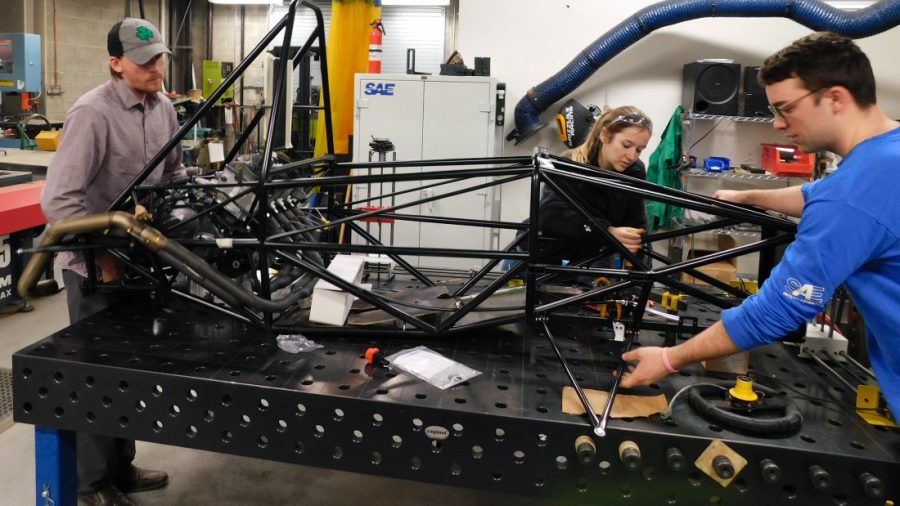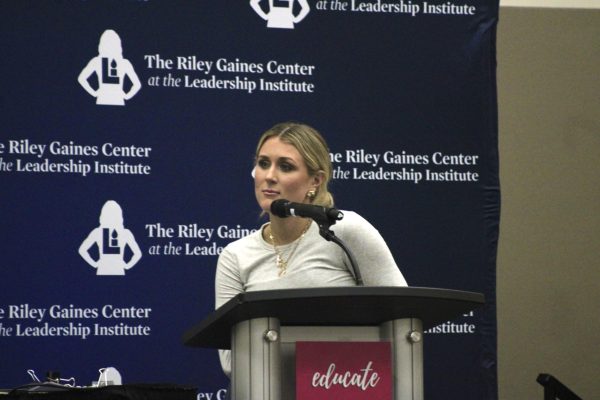Grizzlies Racing competes at FSAE events in Michigan and Ontario, prepares for Germany competition
From left: Gavin McPherson, Bella Lane and Adam Delbeke work on the GRX9. Control arms have been added to the sides and the engine has exhaust pipes.
Around the turn of the century, the Ford Model T entered mass production. In factories like the Highland Park plant on Woodward, laborers were able to produce a drivable car with only the essentials in under three hours.
At Oakland University, a car is built by a team of students between two shops in about a year.
Grizzlies Racing, the OU team competing in Formula Society of Automotive Engineers (FSAE) events across the world, created the GRX9 during the Fall 2018 and Winter 2019 semesters to compete across the world. The 2019 events sent Grizzlies Racing to Brooklyn, Mich. and Barry, Ontario. The team will travel to Hockenheim, Germany in August.
Once the final event of the season ends, Grizzlies Racing begins work on the next car.
“It was in the last few weeks of August when we sent out the frame,” said Adam Delbeke, president of Grizzlies Racing. “The car building process starts with the leadership and what they want to get out of the car for this year. We wanted to iterate on last year’s design to complete the car on time, and we were satisfied with how the car ran by the end of the competition season.”
Once the team at-large decides on the objectives, the sub teams begin to figure out their goals. The designing process ends around November, kicking off the full production period. This is when parts are machined, welded and attached to the car.
“This year, [the manufacturing process] is getting a lot better,” Delbeke said. “We are starting to make drawings to line people up, so we are kind of making a manufacturing side. Where last year or the year before, it was up to the lead [to say] whoever was managing the part and designing it … Obviously there are going to be issues because we are young engineers. We do not understand everything, but we usually overcome them with assembly after some time.”
While OU is not unique for having an FSAE program — Michigan State, University of Michigan and Wayne State are some of the local schools to take part in the international competition — it is the hands-on approach to the manufacturing process that sets Grizzlies Racing apart from its competitors.
“All the manufacturing we do is in-house,” Delbeke said. “Having the students design their parts and then also work with them, while I think other schools rely on their sponsors. It really helps the students and the members of the team … We have a great facility here that allows us not only learn about design but how to manufacture components and makes us better engineers at the end of the day.
The Grizzlies Racing and the GRX9 competed at FSAE Michigan from May 8–11, placing 58th out of the 120 entrants. The team was able to take part in all events but had to be pulled out of the endurance event due to a suspension failure. But Nivisa Vakeesan, head of business and marketing, is certain the team will be ready for the Formula Student Germany competition from Aug. 5–11.
“Some of our team members are pretty disappointed,” Vakeesan said. “Obviously, everyone has their own different views — some people are pessimistic, some people are optimistic … but from what I have seen, a lot of people are like, ‘Okay let’s get our head back in the game.’”







